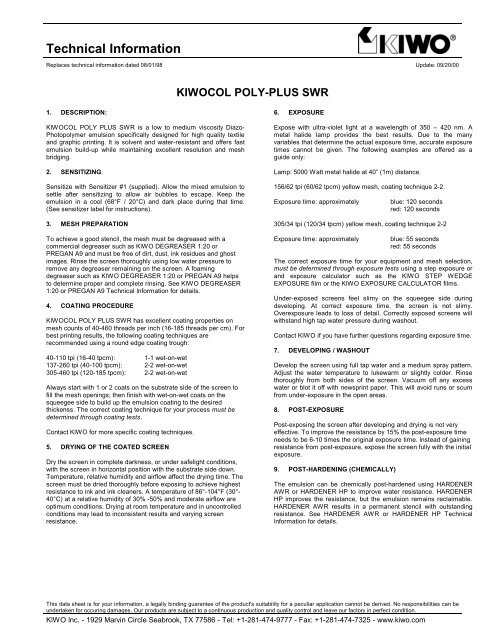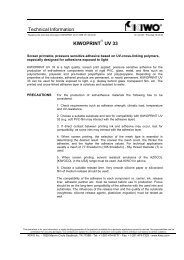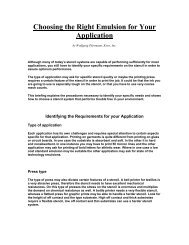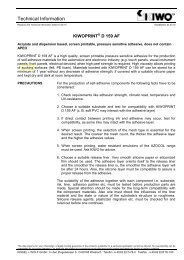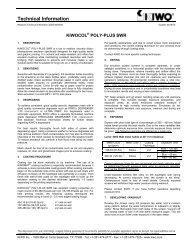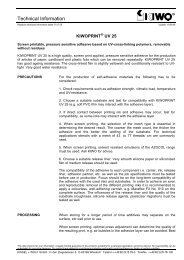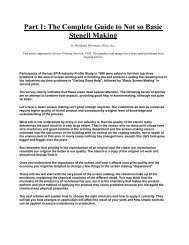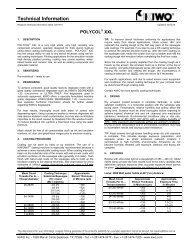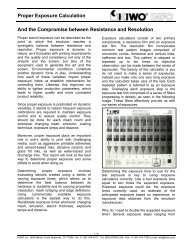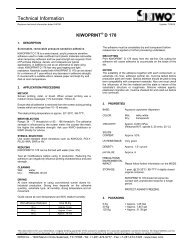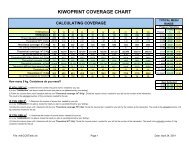Create successful ePaper yourself
Turn your PDF publications into a flip-book with our unique Google optimized e-Paper software.
<strong>Technical</strong> <strong>Information</strong><br />
Replaces technical information dated 08/01/98 Update: 09/20/00<br />
<strong>KIWO</strong>COL POLY-PLUS SWR<br />
1. DESCRIPTION:<br />
<strong>KIWO</strong>COL POLY PLUS SWR is a low to medium viscosity Diazo-<br />
Photopolymer emulsion specifically designed for high quality textile<br />
and graphic printing. It is solvent and water-resistant and offers fast<br />
emulsion build-up while maintaining excellent resolution and mesh<br />
bridging.<br />
2. SENSITIZING:<br />
Sensitize with Sensitizer #1 (supplied). Allow the mixed emulsion to<br />
settle after sensitizing to allow air bubbles to escape. Keep the<br />
emulsion in a cool (68°F / 20°C) and dark place during that time.<br />
(See sensitizer label for instructions).<br />
3. MESH PREPARATION<br />
To achieve a good stencil, the mesh must be degreased with a<br />
commercial degreaser such as <strong>KIWO</strong> DEGREASER 1:20 or<br />
PREGAN A9 and must be free of dirt, dust, ink residues and ghost<br />
images. Rinse the screen thoroughly using low water pressure to<br />
remove any degreaser remaining on the screen. A foaming<br />
degreaser such as <strong>KIWO</strong> DEGREASER 1:20 or PREGAN A9 helps<br />
to determine proper and complete rinsing. See <strong>KIWO</strong> DEGREASER<br />
1:20 or PREGAN A9 <strong>Technical</strong> <strong>Information</strong> for details.<br />
4. COATING PROCEDURE<br />
<strong>KIWO</strong>COL POLY PLUS SWR has excellent coating properties on<br />
mesh counts of 40-460 threads per inch (16-185 threads per cm). For<br />
best printing results, the following coating techniques are<br />
recommended using a round edge coating trough:<br />
40-110 tpi (16-40 tpcm): 1-1 wet-on-wet<br />
137-260 tpi (40-100 tpcm): 2-2 wet-on-wet<br />
305-460 tpi (120-185 tpcm): 2-2 wet-on-wet<br />
Always start with 1 or 2 coats on the substrate side of the screen to<br />
fill the mesh openings; then finish with wet-on-wet coats on the<br />
squeegee side to build up the emulsion coating to the desired<br />
thickenss. The correct coating technique for your process must be<br />
determined through coating tests.<br />
Contact <strong>KIWO</strong> for more specific coating techniques.<br />
5. DRYING OF THE COATED SCREEN<br />
Dry the screen in complete darkness, or under safelight conditions,<br />
with the screen in horizontal position with the substrate side down.<br />
Temperature, relative humidity and airflow affect the drying time. The<br />
screen must be dried thoroughly before exposing to achieve highest<br />
resistance to ink and ink cleaners. A temperature of 86°-104°F (30°-<br />
40°C) at a relative humidity of 30% -50% and moderate airflow are<br />
optimum conditions. Drying at room temperature and in uncontrolled<br />
conditions may lead to inconsistent results and varying screen<br />
resistance.<br />
6. EXPOSURE<br />
Expose with ultra-violet light at a wavelength of 350 – 420 nm. A<br />
metal halide lamp provides the best results. Due to the many<br />
variables that determine the actual exposure time, accurate exposure<br />
times cannot be given. The following examples are offered as a<br />
guide only:<br />
Lamp: 5000 Watt metal halide at 40” (1m) distance.<br />
156/62 tpi (60/62 tpcm) yellow mesh, coating technique 2-2.<br />
Exposure time: approximately<br />
blue: 120 seconds<br />
red: 120 seconds<br />
305/34 tpi (120/34 tpcm) yellow mesh, coating technique 2-2<br />
Exposure time: approximately<br />
blue: 55 seconds<br />
red: 55 seconds<br />
The correct exposure time for your equipment and mesh selection,<br />
must be determined through exposure tests using a step exposure or<br />
and exposure calculator such as the <strong>KIWO</strong> STEP WEDGE<br />
EXPOSURE film or the <strong>KIWO</strong> EXPOSURE CALCULATOR films.<br />
Under-exposed screens feel slimy on the squeegee side during<br />
developing. At correct exposure time, the screen is not slimy.<br />
Overexposure leads to loss of detail. Correctly exposed screens will<br />
withstand high tap water pressure during washout.<br />
Contact <strong>KIWO</strong> if you have further questions regarding exposure time.<br />
7. DEVELOPING / WASHOUT<br />
Develop the screen using full tap water and a medium spray pattern.<br />
Adjust the water temperature to lukewarm or slightly colder. Rinse<br />
thoroughly from both sides of the screen. Vacuum off any excess<br />
water or blot it off with newsprint paper. This will avoid runs or scum<br />
from under-exposure in the open areas.<br />
8. POST-EXPOSURE<br />
Post-exposing the screen after developing and drying is not very<br />
effective. To improve the resistance by 15% the post-exposure time<br />
needs to be 6-10 times the original exposure time. Instead of gaining<br />
resistance from post-exposure, expose the screen fully with the initial<br />
exposure.<br />
9. POST-HARDENING (CHEMICALLY)<br />
The emulsion can be chemically post-hardened using HARDENER<br />
AWR or HARDENER HP to improve water resistance. HARDENER<br />
HP improves the resistance, but the emulsion remains reclaimable.<br />
HARDENER AWR results in a permanent stencil with outstanding<br />
resistance. See HARDENER AWR or HARDENER HP <strong>Technical</strong><br />
<strong>Information</strong> for details.<br />
This data sheet is for your information, a legally binding guarantee of the product's suitability for a peculiar application cannot be derived. No responsibilities can be<br />
undertaken for occuring damages. Our products are subject to a continuous production and quality control and leave our factory in perfect condition.<br />
<strong>KIWO</strong> Inc. - 1929 Marvin Circle Seabrook, TX 77586 - Tel: +1-281-474-9777 - Fax: +1-281-474-7325 - www.kiwo.com
<strong>Technical</strong> <strong>Information</strong><br />
<strong>KIWO</strong>COL POLY-PLUS SWR<br />
Page 2 of 2<br />
Update:09/20/00<br />
10. BLOCKOUT / TOUCH-UP<br />
When printing with solvent based inks, retouching and blocking out<br />
can be done with <strong>KIWO</strong> TOUCH-UP and <strong>KIWO</strong> BLOCKOUT. For<br />
water resistant stencils, block out and retouch with <strong>KIWO</strong><br />
BLOCKOUT WR/MV or use <strong>KIWO</strong>COL POLY PLUS SWR (dry<br />
thoroughly and re-expose completely prior to using HARDENER<br />
AWR or HARDENER HP). See <strong>KIWO</strong> TOUCH-UP, <strong>KIWO</strong><br />
BLOCKOUT, and <strong>KIWO</strong> BLOCKOUT WR/MV <strong>Technical</strong> <strong>Information</strong><br />
for details.<br />
11. DECOATING<br />
<strong>KIWO</strong>COL POLY PLUS SWR can be decoated with emulsion<br />
removers such as <strong>KIWO</strong> STENCIL REMOVER. Before decoating,<br />
ensure the screen is completely cleaned of ink or ink cleaning<br />
chemical residues. If water beads up on the stencil, degrease the<br />
screen prior to decoating. See the <strong>KIWO</strong> STENCIL REMOVER<br />
<strong>Technical</strong> <strong>Information</strong> for details. If the screen was chemically<br />
hardened with HARDENER AWR, reclaiming is no longer possible.<br />
13. PHYSICAL PROPERTIES<br />
Viscosity:<br />
Viscosity sensitized:<br />
approx.: 10,000 mPas<br />
approx.: 5,000 mPas<br />
Solids Content: approx.: 36%<br />
Color:<br />
Color Sensitized:<br />
Storage:<br />
Potlife:<br />
light blue/light red<br />
light green/light red<br />
1 year at 68°F/20°C<br />
4-6 weeks at 68°F/20°C<br />
Precoated screens: 1-3 weeks in complete<br />
darkness at 68°F/20°C<br />
Freezing:<br />
VOC:<br />
protect against freezing<br />
none<br />
12. HAZE REMOVING<br />
TLV:<br />
n/a<br />
When under-exposed, the emulsion can cause emulsion haze after<br />
reclaiming. To remove haze, use <strong>KIWO</strong> HAZE REMOVER or<br />
PREGAN PASTE. Use the haze removing products with the <strong>KIWO</strong><br />
INK WASH or <strong>KIWO</strong> ULTIMATE INK WASH. These products are<br />
also very effective at removing ink haze. See separate <strong>Technical</strong><br />
<strong>Information</strong> for these additional products for more details.<br />
HMIS rating: Health – 1<br />
Flammability – 0<br />
Reactivity – 0<br />
14. PACKAGING<br />
1 US Quart, 1 US Gallon, 5 US Gallons, 55 US Gallon Drum.<br />
15. ADDITIONAL INFORMATION<br />
For additional product information, please visit our web site at<br />
www.kiwo.com. All products mentioned in this <strong>Technical</strong> <strong>Information</strong><br />
sheet are available through <strong>KIWO</strong> Inc. and its distributor network. For<br />
further information contact your <strong>KIWO</strong> distributor or <strong>KIWO</strong> direct.<br />
Thank you for choosing <strong>KIWO</strong>.


